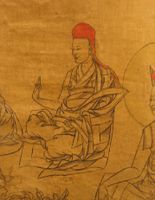ShAkya mchog ldan: Difference between revisions
No edit summary |
No edit summary |
||
| Line 1: | Line 1: | ||
{{Person | {{Person | ||
|HasDrlPage=Yes | |HasDrlPage=Yes | ||
|HasLibPage=No | |HasLibPage=No | ||
| Line 8: | Line 5: | ||
|HasDnzPage=No | |HasDnzPage=No | ||
|HasBnwPage=Yes | |HasBnwPage=Yes | ||
|pagename=ShAkya mchog ldan | |||
|PersonType=Classical Tibetan Authors | |||
|images=File:Shakya Chokden.jpg{{!}}[https://www.himalayanart.org/items/65562/images/65562k#-992,-1600,2191,0 Himalayan Art Resources] | |||
|MainNamePhon=Śākya Chokden | |MainNamePhon=Śākya Chokden | ||
|SortName=Shākya Chokden | |||
|MainNameTib=ཤཱཀྱ་མཆོག་ལྡན་ | |MainNameTib=ཤཱཀྱ་མཆོག་ལྡན་ | ||
|MainNameWylie=shAkya mchog ldan | |MainNameWylie=shAkya mchog ldan | ||
Revision as of 11:43, 9 September 2020
| PersonType | Category:Classical Tibetan Authors |
|---|---|
| MainNamePhon | Śākya Chokden |
| MainNameTib | ཤཱཀྱ་མཆོག་ལྡན་ |
| MainNameWylie | shAkya mchog ldan |
| SortName | Shākya Chokden |
| YearBirth | 1428 |
| YearDeath | 1507 |
| BornIn | gsang mda' bang rim |
| TibDateGender | Male |
| TibDateElement | Earth |
| TibDateAnimal | Monkey |
| TibDateRabjung | 7 |
| ReligiousAffiliation | Sakya |
| ClassicalProfAff | Sangpu Neutok |
| StudentOf | rong ston shes bya kun rig · don yod dpal ba · Ngorchen Kunga Zangpo · spyang lung chos sdings gzhon nu blo gros |
| BDRC | https://www.tbrc.org/#!rid=P396 |
| Treasury of Lives | https://treasuryoflives.org/biographies/view/%C5%9A%C4%81kya-Chokden/6351 |
| IsInGyatsa | No |
| PosBuNayDefProv | Definitive |
| PosBuNayDefProvNotes | Though his unique presentation allows for both definitive and provisional versions of buddha-nature. The distinction between the two depends on whether there is direct experience of the unstained buddha-nature and its corresponding qualities, or, alternatively whether this nature is latently present in an obscured form. |
| PosAllBuddha | Qualified No |
| PosAllBuddhaNote | All beings possess a "nominal" buddha-nature as is taught in the second-wheel teachings, while only bodhisattvas on the first bhumi and up (i.e. Noble Bodhisattvas) possess the "actual" buddha-nature as it was taught in the third-wheel teachings. (see note from Brunnhölzl below) |
| PosAllBuddhaMoreNotes |
|
| PosWheelTurn | Third Turning |
| PosWheelTurnNotes | He distinguishes between different types of buddha-nature taught in the second and third wheels, though the third is the more definitive and represents the "actual" tathāgatagarbha. |
| PosYogaMadhya | Madhyamaka |
| PosEmptyLumin | There are several types of Tathāgatagarbha |
| PosEmptyLuminNotes |
|
| Other wikis |
If the page does not yet exist on the remote wiki, you can paste the tag |

